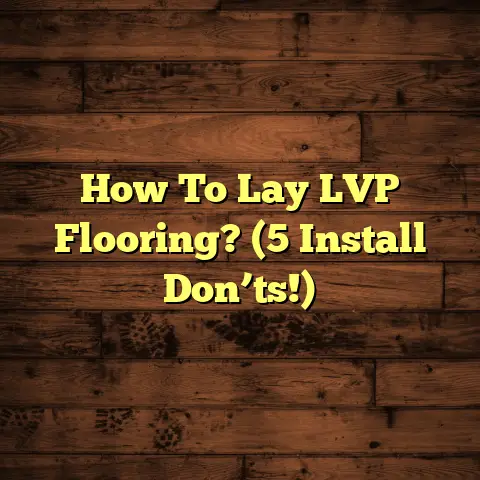Vinyl Tiles on Concrete? (4 Steps Before Install!)
I’ve been in this business for over 15 years, and I’ve seen a massive shift in what people want from their floors. It’s not just about looks anymore. People want durability, affordability, and, increasingly, sustainability.
That’s where vinyl tiles come in!
They’re versatile, tough, and can be a really eco-conscious choice, especially when installed over concrete.
Think about it: you’re minimizing the need for brand-new materials, reducing waste. But, and this is a big BUT, you can’t just slap those tiles down and hope for the best.
You need to prep the concrete properly. Trust me, I’ve seen the disasters that happen when you don’t. So, let’s dive into the four essential steps to get it right!
Step 1: Assessing the Concrete Subfloor
Okay, first things first, we gotta play detective. We need to figure out the condition of that concrete slab. Is it dry? Are there cracks? Is it level?
These are the questions that can make or break your vinyl tile install.
- Moisture Testing:
Concrete is like a giant sponge. It soaks up moisture from the ground, and that moisture can wreak havoc on your vinyl tiles.
I remember one job where the homeowner skipped the moisture test. A few months later, the tiles started peeling up, and there was mold underneath. Nightmare scenario!
So, how do you test for moisture?
Well, there are a couple of ways. The easiest is with a moisture meter. You can pick one up at any hardware store.
Just follow the instructions, and it’ll give you a reading.
Anything above 4% is a red flag.
Another method, the one I often use, is the plastic sheeting test.
You tape a 2×2 foot piece of clear plastic sheeting to the concrete floor with duct tape, sealing all the edges. Then, wait 24-48 hours. If you see condensation under the plastic, or the concrete looks darker, you’ve got a moisture problem.
According to the Portland Cement Association, excessive moisture can reduce the lifespan of flooring adhesives by up to 50%. That’s a HUGE difference!
- Crack and Damage Inspection:
Next up, let’s look for cracks, chips, and other damage.
Small hairline cracks are usually no big deal. You can fill them with a concrete crack filler.
But if you’re seeing wide cracks (more than 1/8 inch), or if the concrete is crumbling, you’ve got bigger problems.
Those could indicate structural issues, and you’ll want to call in a professional to take a look.
Ignoring these issues is like putting a band-aid on a broken leg. It won’t fix the underlying problem, and it’ll just get worse over time.
- Surface Leveling:
Finally, let’s talk about leveling.
An uneven concrete surface is a vinyl tile’s worst enemy. It can lead to tiles cracking, lifting, or just looking plain awful.
I’ve used self-leveling concrete compounds on many projects. These are easy to apply and can create a perfectly smooth surface.
Just pour it on, spread it around, and let it do its thing.
Make sure to follow the manufacturer’s instructions carefully.
Step 2: Selecting the Right Vinyl Tile Type
Alright, now that we know what we’re dealing with, let’s talk about vinyl tiles!
Not all vinyl tiles are created equal. You’ve got LVT, VCT, and peel-and-stick.
Each has its pros and cons, so let’s break it down.
- Luxury Vinyl Tiles (LVT):
LVT is the king of vinyl tiles, in my opinion. It looks fantastic, it’s super durable, and it comes in a ton of different styles.
You can get LVT that looks like wood, stone, or even ceramic tile.
The key is the wear layer. This is the top layer that protects the tile from scratches and stains.
The thicker the wear layer, the more durable the tile.
I recommend at least a 20-mil wear layer for high-traffic areas.
LVT is also water-resistant, making it a great choice for kitchens and bathrooms.
According to a report by MarketWatch, the global LVT market is expected to reach $45 billion by 2027. That tells you something about its popularity!
- Vinyl Composite Tiles (VCT):
VCT is the budget-friendly option. It’s made from a mixture of vinyl and other materials.
It’s durable, but it doesn’t have the same realistic look as LVT.
VCT also requires regular maintenance, including waxing and polishing, to keep it looking its best.
I’ve used VCT in commercial settings where budget is a major concern.
- Peel-and-Stick Tiles:
Peel-and-stick tiles are the easiest to install. Just peel off the backing and stick them to the floor.
They’re great for DIY projects and temporary installations.
However, they’re not as durable as LVT or VCT.
I’ve seen peel-and-stick tiles peel up and shift over time, especially in high-traffic areas.
So, choose wisely!
Consider the room’s function, your budget, and your aesthetic preferences.
And don’t forget about sustainability!
Look for vinyl tiles that are made from recycled materials or that are FloorScore certified for low VOC emissions.
Step 3: Preparing the Concrete Surface
Okay, we’ve got our tiles, now it’s time to get that concrete ready!
This is where the magic happens, folks.
A clean, smooth, and primed surface is essential for a successful vinyl tile installation.
- Thorough Cleaning:
First, sweep and vacuum the concrete to remove all dust, dirt, and debris.
Then, wash the surface with a cleaner specifically designed for concrete.
I like to use a degreaser to remove any oils or residues.
Rinse the surface thoroughly with clean water and let it dry completely.
I can’t stress this enough: the cleaner the surface, the better the adhesion.
- Applying a Primer:
Next, apply a primer. A primer helps the adhesive bond to the concrete.
It also seals the surface and prevents moisture from migrating through the concrete.
Choose a primer that is compatible with both the vinyl tile and the adhesive you’ll be using.
Apply the primer according to the manufacturer’s instructions.
Typically, you’ll need to apply one or two coats, allowing each coat to dry completely before applying the next.
- Final Inspection:
Before you start laying tiles, take one last look at the concrete surface.
Make sure it’s dry, smooth, and free of any debris.
Run your hand over the surface to feel for any imperfections.
If you find any, address them before moving on.
A little extra effort at this stage can save you a lot of headaches down the road.
Step 4: Acclimating the Vinyl Tiles
Almost there!
This last step is often overlooked, but it’s crucial for preventing problems down the line.
Acclimating the vinyl tiles to the room’s temperature and humidity helps them expand and contract properly.
- Acclimation Process:
Remove the vinyl tiles from their packaging and lay them flat in the room where they’ll be installed.
Allow them to acclimate for at least 48 hours.
I prefer 72 hours, just to be safe.
Make sure the room temperature is between 65°F and 85°F (18°C and 29°C).
This allows the tiles to adjust to the room’s environment.
- Monitoring Humidity Levels:
Use a hygrometer to monitor the humidity levels in the room.
Ideally, the humidity should be between 30% and 50%.
If the humidity is too high, use a dehumidifier to lower it.
If it’s too low, use a humidifier to raise it.
Maintaining the proper humidity levels will prevent the tiles from expanding or contracting excessively after installation.
- Final Preparations:
After the acclimation period, inspect the tiles for any defects or damage.
Make sure you have enough tiles to complete the project, accounting for waste and cuts.
It’s always a good idea to have a few extra tiles on hand in case you need to make repairs in the future.
Conclusion: Embracing Sustainable Flooring Solutions
And there you have it!
The four essential steps to take before installing vinyl tiles on concrete.
By following these steps, you can ensure a successful and long-lasting installation.
But more than that, you’re making a conscious choice to embrace sustainable flooring solutions.
You’re reducing waste, minimizing your environmental impact, and creating a healthier living environment.
So, go forth and install those vinyl tiles with confidence!
You’ve got the knowledge, you’ve got the tools, and you’ve got the commitment to sustainability.
Happy flooring!





